General Electric Case Study: Leadership and Strategic Options
VerifiedAdded on 2020/03/23
|22
|4893
|1861
Case Study
AI Summary
This case study examines General Electric (GE), a multinational conglomerate. It begins with an introduction to GE, its diverse segments, and its ranking among the largest firms in America. The study then delves into GE's core competencies and capabilities, including new product development, excellence, human resource management, and diversification, as well as leadership, workforce collaboration, research and development, and customer value. The VRIO framework and value chain analysis model are utilized to analyze these competencies. The case study further explores GE's strategic options for the next five years, using SWOT analysis to identify strengths, weaknesses, opportunities, and threats. Finally, it compares the management approaches of former CEO Jack Welch and current CEO Jeffrey Immelt, offering insights for future strategic direction.
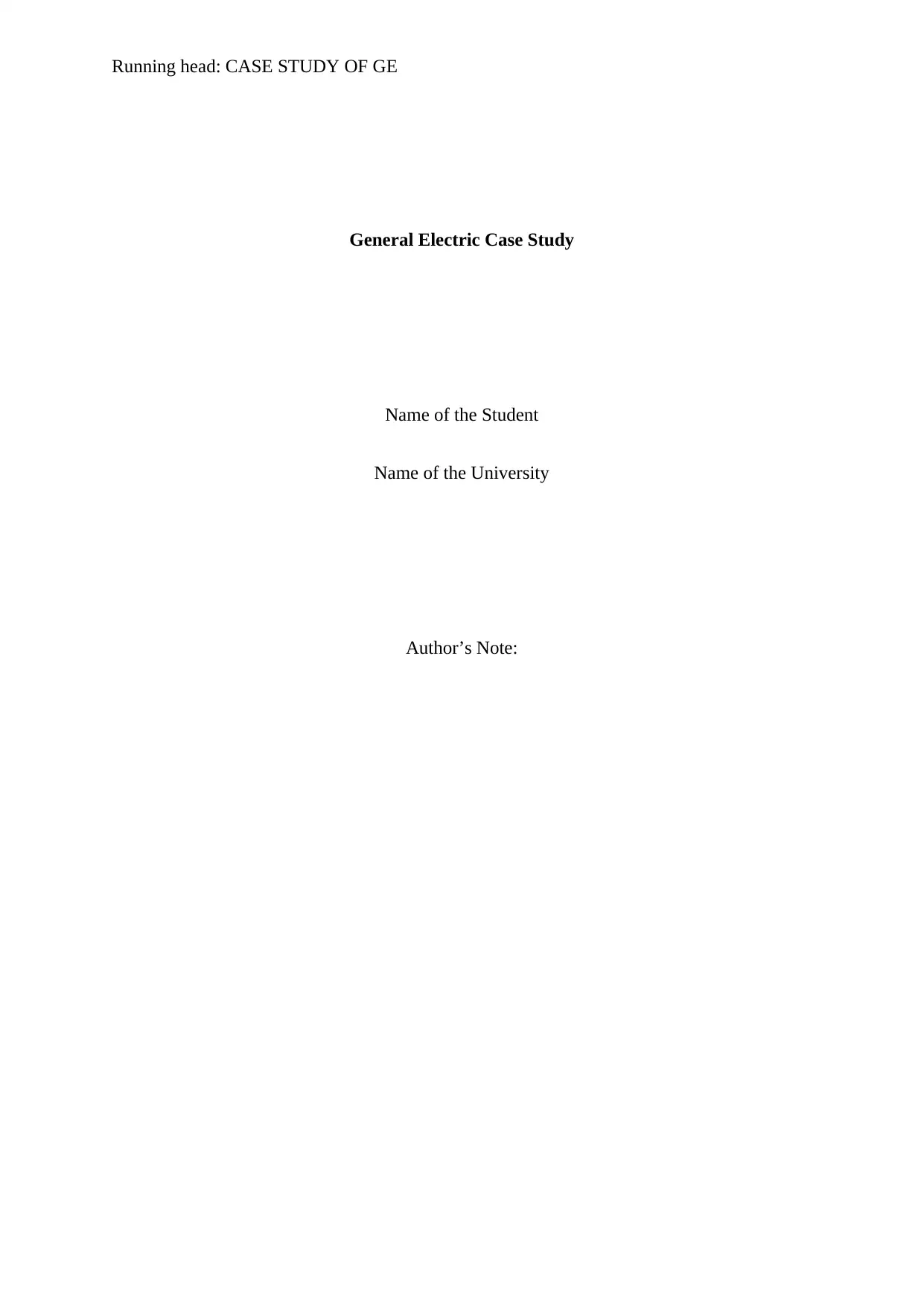
Running head: CASE STUDY OF GE
General Electric Case Study
Name of the Student
Name of the University
Author’s Note:
General Electric Case Study
Name of the Student
Name of the University
Author’s Note:
Paraphrase This Document
Need a fresh take? Get an instant paraphrase of this document with our AI Paraphraser
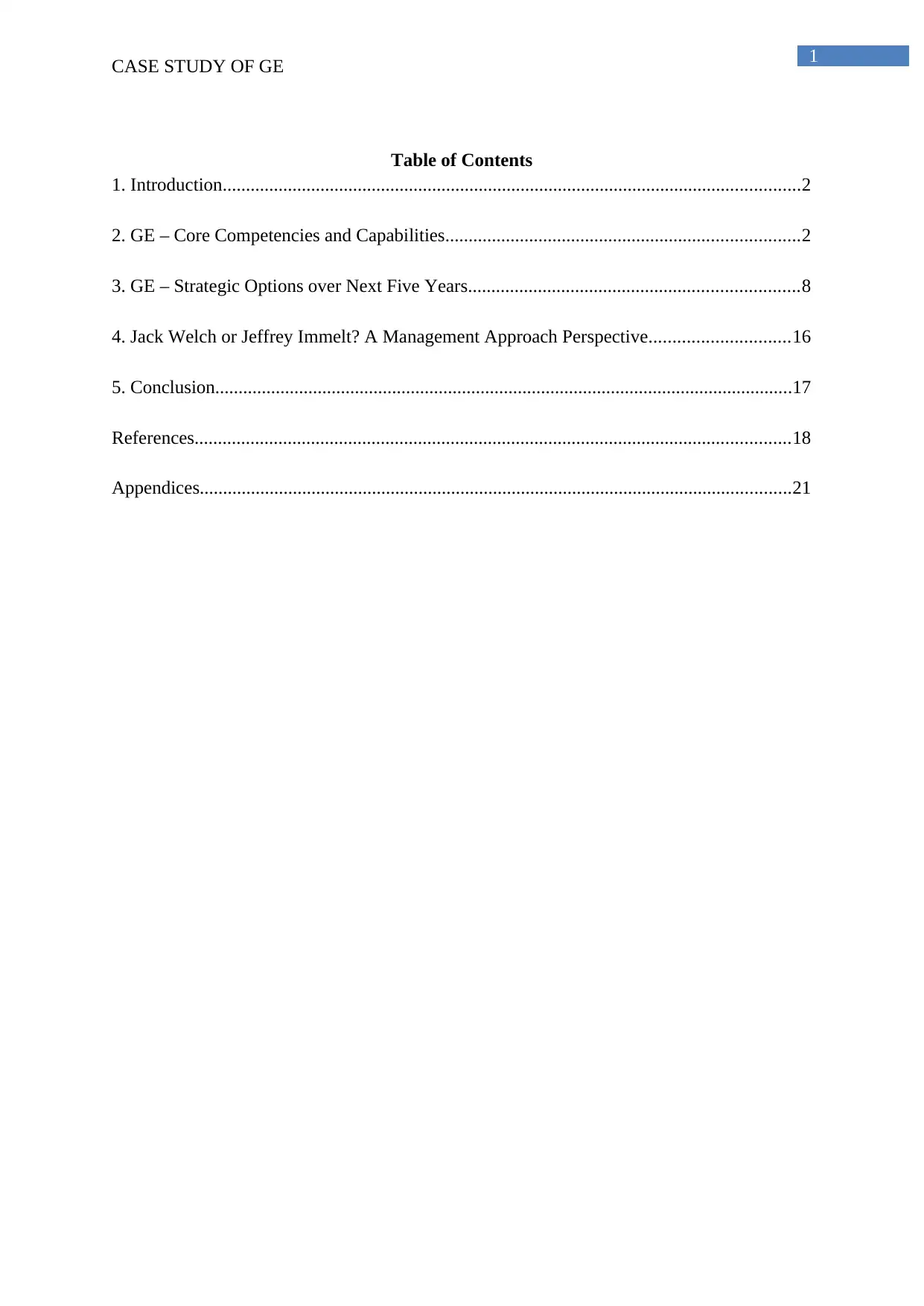
1
CASE STUDY OF GE
Table of Contents
1. Introduction............................................................................................................................2
2. GE – Core Competencies and Capabilities............................................................................2
3. GE – Strategic Options over Next Five Years.......................................................................8
4. Jack Welch or Jeffrey Immelt? A Management Approach Perspective..............................16
5. Conclusion............................................................................................................................17
References................................................................................................................................18
Appendices...............................................................................................................................21
CASE STUDY OF GE
Table of Contents
1. Introduction............................................................................................................................2
2. GE – Core Competencies and Capabilities............................................................................2
3. GE – Strategic Options over Next Five Years.......................................................................8
4. Jack Welch or Jeffrey Immelt? A Management Approach Perspective..............................16
5. Conclusion............................................................................................................................17
References................................................................................................................................18
Appendices...............................................................................................................................21
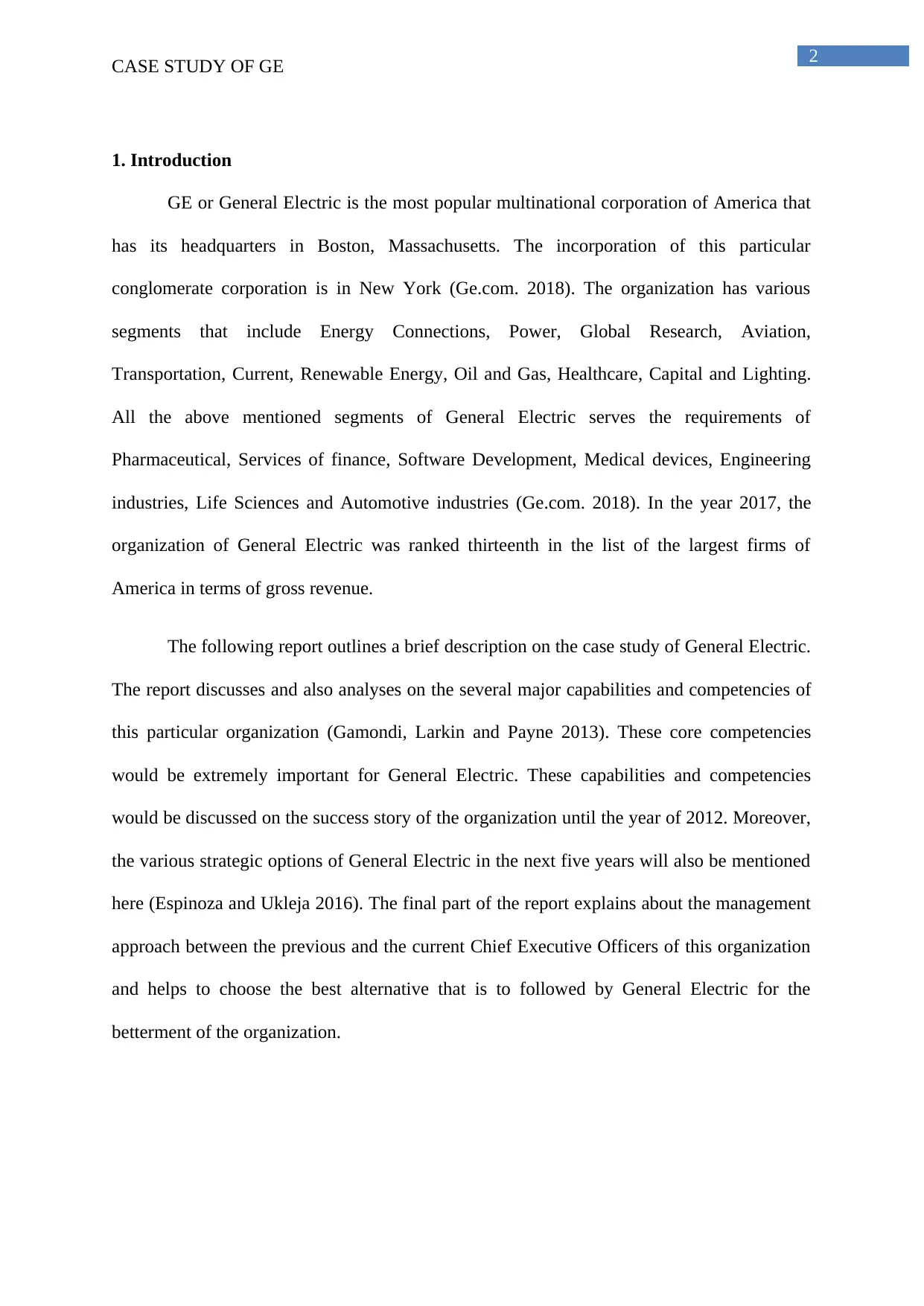
2
CASE STUDY OF GE
1. Introduction
GE or General Electric is the most popular multinational corporation of America that
has its headquarters in Boston, Massachusetts. The incorporation of this particular
conglomerate corporation is in New York (Ge.com. 2018). The organization has various
segments that include Energy Connections, Power, Global Research, Aviation,
Transportation, Current, Renewable Energy, Oil and Gas, Healthcare, Capital and Lighting.
All the above mentioned segments of General Electric serves the requirements of
Pharmaceutical, Services of finance, Software Development, Medical devices, Engineering
industries, Life Sciences and Automotive industries (Ge.com. 2018). In the year 2017, the
organization of General Electric was ranked thirteenth in the list of the largest firms of
America in terms of gross revenue.
The following report outlines a brief description on the case study of General Electric.
The report discusses and also analyses on the several major capabilities and competencies of
this particular organization (Gamondi, Larkin and Payne 2013). These core competencies
would be extremely important for General Electric. These capabilities and competencies
would be discussed on the success story of the organization until the year of 2012. Moreover,
the various strategic options of General Electric in the next five years will also be mentioned
here (Espinoza and Ukleja 2016). The final part of the report explains about the management
approach between the previous and the current Chief Executive Officers of this organization
and helps to choose the best alternative that is to followed by General Electric for the
betterment of the organization.
CASE STUDY OF GE
1. Introduction
GE or General Electric is the most popular multinational corporation of America that
has its headquarters in Boston, Massachusetts. The incorporation of this particular
conglomerate corporation is in New York (Ge.com. 2018). The organization has various
segments that include Energy Connections, Power, Global Research, Aviation,
Transportation, Current, Renewable Energy, Oil and Gas, Healthcare, Capital and Lighting.
All the above mentioned segments of General Electric serves the requirements of
Pharmaceutical, Services of finance, Software Development, Medical devices, Engineering
industries, Life Sciences and Automotive industries (Ge.com. 2018). In the year 2017, the
organization of General Electric was ranked thirteenth in the list of the largest firms of
America in terms of gross revenue.
The following report outlines a brief description on the case study of General Electric.
The report discusses and also analyses on the several major capabilities and competencies of
this particular organization (Gamondi, Larkin and Payne 2013). These core competencies
would be extremely important for General Electric. These capabilities and competencies
would be discussed on the success story of the organization until the year of 2012. Moreover,
the various strategic options of General Electric in the next five years will also be mentioned
here (Espinoza and Ukleja 2016). The final part of the report explains about the management
approach between the previous and the current Chief Executive Officers of this organization
and helps to choose the best alternative that is to followed by General Electric for the
betterment of the organization.
⊘ This is a preview!⊘
Do you want full access?
Subscribe today to unlock all pages.

Trusted by 1+ million students worldwide

3
CASE STUDY OF GE
2. GE – Core Competencies and Capabilities
The core competencies of an organization can be defined as the specific concepts in
management that has a unique combination of several skills and resources for distinguishing
the position of a firm in market (Walsh et al. 2012). The core competencies of any
organization help to obtain competitive advantages. There are three distinct criteria for the
fulfilment of core competencies. They are as follows:
i) The core competencies help to provide proper potential access to the broad range of
markets (Calzada, Prado and Marzal 2013).
ii) The core competencies always make the most important contribution to all the
advantages of a product.
iii) The third criterion for the core competencies is the difficulty in imitating by all the
competitors.
The core competencies help to deliver added values to the specific clients. These are
resulted from a particular set of tools, techniques and skills of production (Davis 2014).
These competencies are always developed from the procedure of constant improvisations
with the time period instead of one big alteration. The utilization and the proper
understanding of the entire conceptualization of the core competencies are extremely
important and beneficial for the organizations (Drucker 2017). The organizations utilize these
core competencies for excelling at their use of knowledge and skills for the creation of
anything effective. Furthermore, the proper values of stakeholders and clients are also raised
with the help of the core competencies. The examples of core competencies are specialized
skills, techniques and even knowledge. The core capability of an organization is the proper
ability of management for the development of the core competencies (Légaré et al. 2013).
The new businesses or the basic products are also developed with the help of core capability.
CASE STUDY OF GE
2. GE – Core Competencies and Capabilities
The core competencies of an organization can be defined as the specific concepts in
management that has a unique combination of several skills and resources for distinguishing
the position of a firm in market (Walsh et al. 2012). The core competencies of any
organization help to obtain competitive advantages. There are three distinct criteria for the
fulfilment of core competencies. They are as follows:
i) The core competencies help to provide proper potential access to the broad range of
markets (Calzada, Prado and Marzal 2013).
ii) The core competencies always make the most important contribution to all the
advantages of a product.
iii) The third criterion for the core competencies is the difficulty in imitating by all the
competitors.
The core competencies help to deliver added values to the specific clients. These are
resulted from a particular set of tools, techniques and skills of production (Davis 2014).
These competencies are always developed from the procedure of constant improvisations
with the time period instead of one big alteration. The utilization and the proper
understanding of the entire conceptualization of the core competencies are extremely
important and beneficial for the organizations (Drucker 2017). The organizations utilize these
core competencies for excelling at their use of knowledge and skills for the creation of
anything effective. Furthermore, the proper values of stakeholders and clients are also raised
with the help of the core competencies. The examples of core competencies are specialized
skills, techniques and even knowledge. The core capability of an organization is the proper
ability of management for the development of the core competencies (Légaré et al. 2013).
The new businesses or the basic products are also developed with the help of core capability.
Paraphrase This Document
Need a fresh take? Get an instant paraphrase of this document with our AI Paraphraser
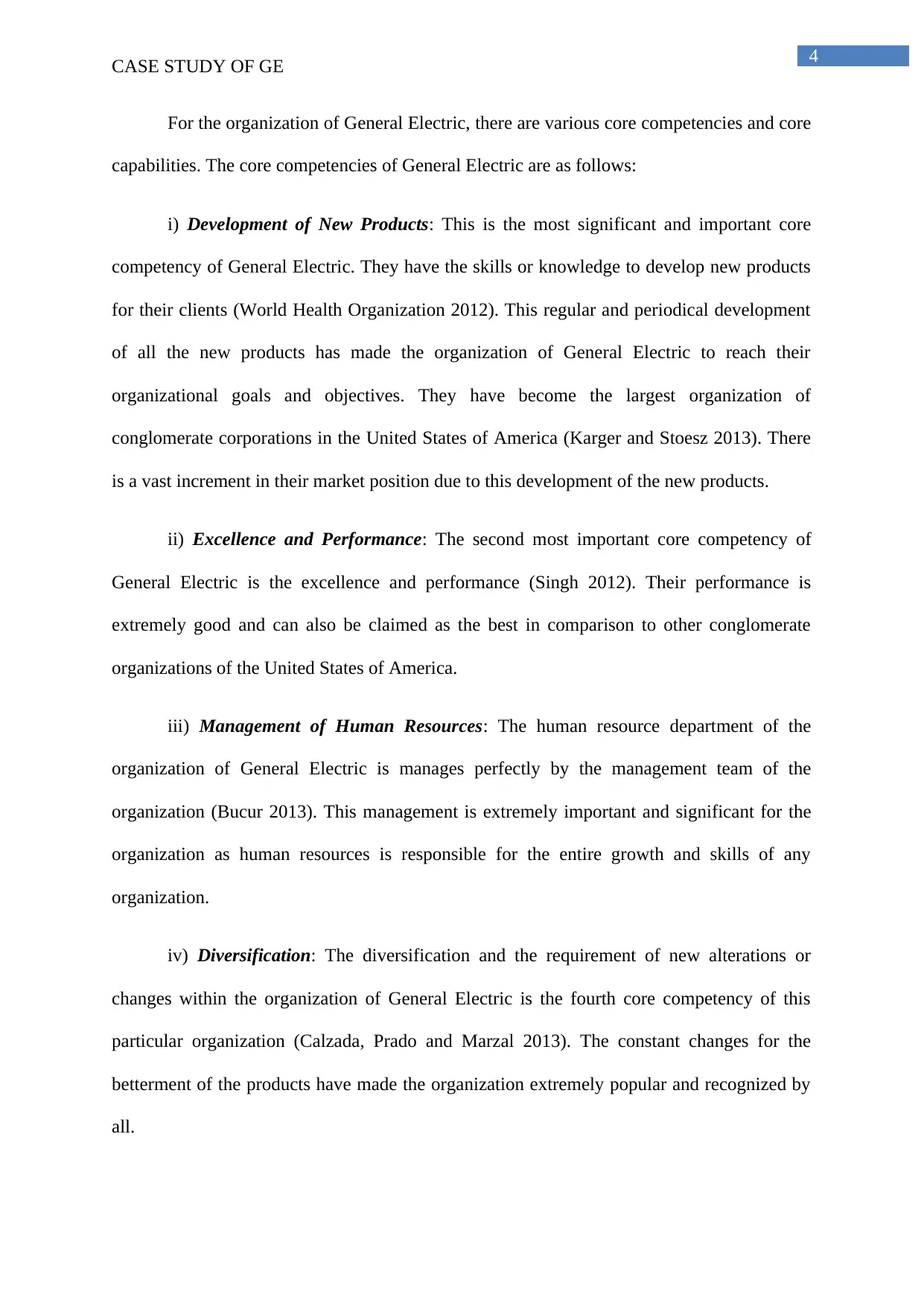
4
CASE STUDY OF GE
For the organization of General Electric, there are various core competencies and core
capabilities. The core competencies of General Electric are as follows:
i) Development of New Products: This is the most significant and important core
competency of General Electric. They have the skills or knowledge to develop new products
for their clients (World Health Organization 2012). This regular and periodical development
of all the new products has made the organization of General Electric to reach their
organizational goals and objectives. They have become the largest organization of
conglomerate corporations in the United States of America (Karger and Stoesz 2013). There
is a vast increment in their market position due to this development of the new products.
ii) Excellence and Performance: The second most important core competency of
General Electric is the excellence and performance (Singh 2012). Their performance is
extremely good and can also be claimed as the best in comparison to other conglomerate
organizations of the United States of America.
iii) Management of Human Resources: The human resource department of the
organization of General Electric is manages perfectly by the management team of the
organization (Bucur 2013). This management is extremely important and significant for the
organization as human resources is responsible for the entire growth and skills of any
organization.
iv) Diversification: The diversification and the requirement of new alterations or
changes within the organization of General Electric is the fourth core competency of this
particular organization (Calzada, Prado and Marzal 2013). The constant changes for the
betterment of the products have made the organization extremely popular and recognized by
all.
CASE STUDY OF GE
For the organization of General Electric, there are various core competencies and core
capabilities. The core competencies of General Electric are as follows:
i) Development of New Products: This is the most significant and important core
competency of General Electric. They have the skills or knowledge to develop new products
for their clients (World Health Organization 2012). This regular and periodical development
of all the new products has made the organization of General Electric to reach their
organizational goals and objectives. They have become the largest organization of
conglomerate corporations in the United States of America (Karger and Stoesz 2013). There
is a vast increment in their market position due to this development of the new products.
ii) Excellence and Performance: The second most important core competency of
General Electric is the excellence and performance (Singh 2012). Their performance is
extremely good and can also be claimed as the best in comparison to other conglomerate
organizations of the United States of America.
iii) Management of Human Resources: The human resource department of the
organization of General Electric is manages perfectly by the management team of the
organization (Bucur 2013). This management is extremely important and significant for the
organization as human resources is responsible for the entire growth and skills of any
organization.
iv) Diversification: The diversification and the requirement of new alterations or
changes within the organization of General Electric is the fourth core competency of this
particular organization (Calzada, Prado and Marzal 2013). The constant changes for the
betterment of the products have made the organization extremely popular and recognized by
all.

5
CASE STUDY OF GE
The core capabilities of General Electric are as follows:
i) Leadership: This is the most significant capability of General Electric (Drucker
2017). They have the unique quality of leadership and thus they are leading the entire market
of conglomerate organizations.
ii) Collaboration of Workforce: The second important capability of General Electric
is the collaboration of workforce (Hitt, Ireland and Hoskisson 2012). All the employees and
the staffs of the organization work together and thus the organizational goals and objectives
are obtained easily and smoothly.
iii) Research and Development: The third significant capability of General Electric is
the research and development (Hill, Jones and Schilling 2014). They have the unique
capability of researching and developing innovative and new products for their business.
iv) Customer Value: The fourth core capability of General Electric is the customer
value. The showing of their values to their customers had brought excellent solutions to their
problems.
The current and the former CEOs i.e. Jack Welch or Jeffrey Immelt have succeeded in
their leadership roles and responsibilities for the organization of General Electric (Peppard
and Ward 2016). All the above mentioned core capabilities and competencies for GE can be
explained with the help of VRIO Framework.
CASE STUDY OF GE
The core capabilities of General Electric are as follows:
i) Leadership: This is the most significant capability of General Electric (Drucker
2017). They have the unique quality of leadership and thus they are leading the entire market
of conglomerate organizations.
ii) Collaboration of Workforce: The second important capability of General Electric
is the collaboration of workforce (Hitt, Ireland and Hoskisson 2012). All the employees and
the staffs of the organization work together and thus the organizational goals and objectives
are obtained easily and smoothly.
iii) Research and Development: The third significant capability of General Electric is
the research and development (Hill, Jones and Schilling 2014). They have the unique
capability of researching and developing innovative and new products for their business.
iv) Customer Value: The fourth core capability of General Electric is the customer
value. The showing of their values to their customers had brought excellent solutions to their
problems.
The current and the former CEOs i.e. Jack Welch or Jeffrey Immelt have succeeded in
their leadership roles and responsibilities for the organization of General Electric (Peppard
and Ward 2016). All the above mentioned core capabilities and competencies for GE can be
explained with the help of VRIO Framework.
⊘ This is a preview!⊘
Do you want full access?
Subscribe today to unlock all pages.

Trusted by 1+ million students worldwide

6
CASE STUDY OF GE
Figure 1: VRIO Framework for the Analysis of General Electric
(Source: Peppard and Ward 2016)
The VRIO framework or the Valuable, Rare, Difficulty in imitation and Support by
Organization framework helps to understand the overall competencies and capabilities of an
organization (Calzada, Prado and Marzal 2013). The competitive implications of this
organization help in understanding the competitive advantages and disadvantages. These
competitive advantages of General Electric are extremely important for the organization.
Moreover, the competitive disadvantages help to understand the overall weaknesses of the
organization (Peppard and Ward 2016). The major competencies of General Electric have
always been the innovation and the significant quality research and development by the
diversification in the products and the management of their human resources. The
management of employees is generally done with the help of motivation and encouragement.
Furthermore, they are provided with relevant opportunities that could be extremely helpful
for the integration of customer solutions (Eden and Ackermann 2013). As General Electric
has various segments and healthcare is the most important segment of this organization, the
CASE STUDY OF GE
Figure 1: VRIO Framework for the Analysis of General Electric
(Source: Peppard and Ward 2016)
The VRIO framework or the Valuable, Rare, Difficulty in imitation and Support by
Organization framework helps to understand the overall competencies and capabilities of an
organization (Calzada, Prado and Marzal 2013). The competitive implications of this
organization help in understanding the competitive advantages and disadvantages. These
competitive advantages of General Electric are extremely important for the organization.
Moreover, the competitive disadvantages help to understand the overall weaknesses of the
organization (Peppard and Ward 2016). The major competencies of General Electric have
always been the innovation and the significant quality research and development by the
diversification in the products and the management of their human resources. The
management of employees is generally done with the help of motivation and encouragement.
Furthermore, they are provided with relevant opportunities that could be extremely helpful
for the integration of customer solutions (Eden and Ackermann 2013). As General Electric
has various segments and healthcare is the most important segment of this organization, the
Paraphrase This Document
Need a fresh take? Get an instant paraphrase of this document with our AI Paraphraser
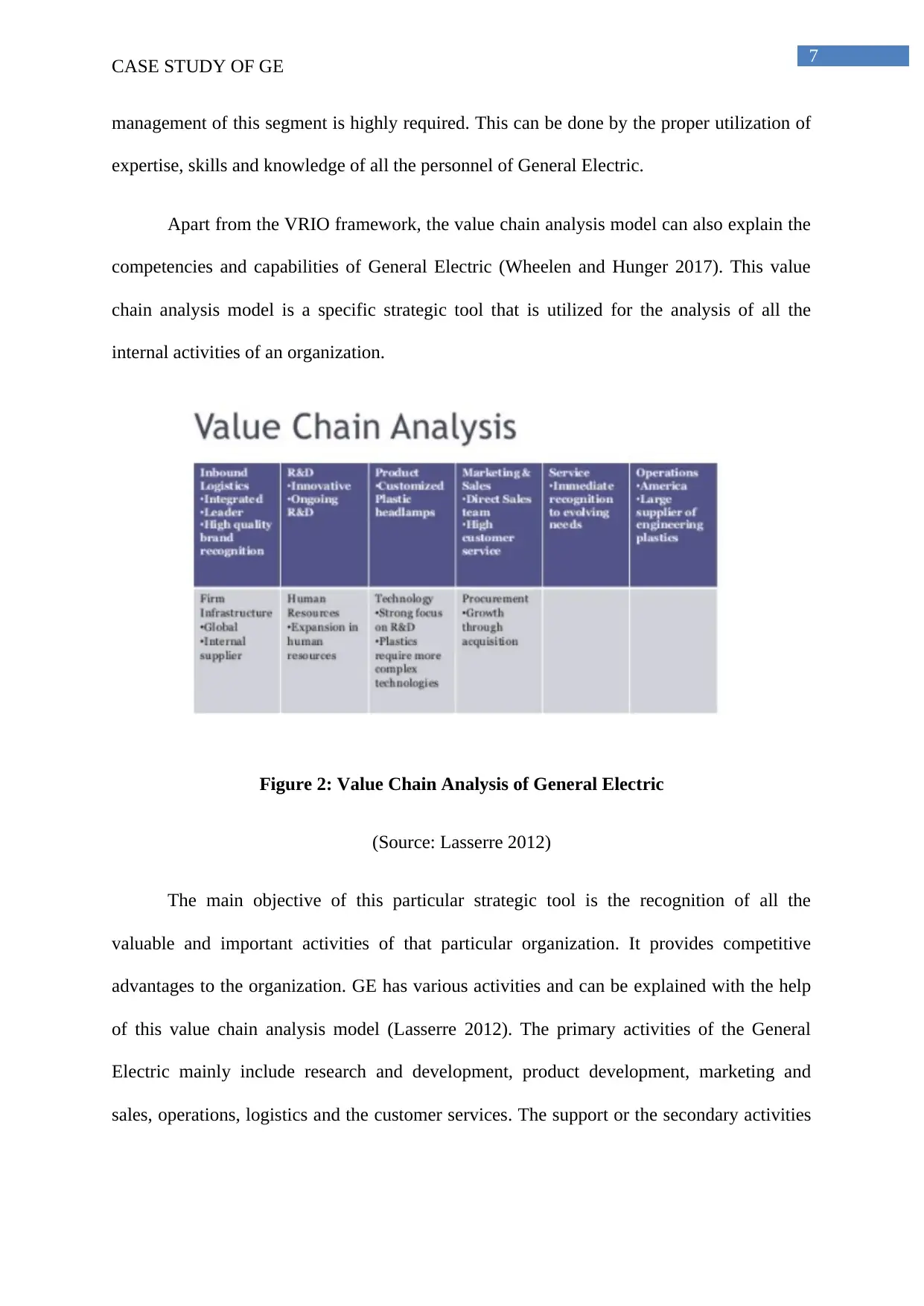
7
CASE STUDY OF GE
management of this segment is highly required. This can be done by the proper utilization of
expertise, skills and knowledge of all the personnel of General Electric.
Apart from the VRIO framework, the value chain analysis model can also explain the
competencies and capabilities of General Electric (Wheelen and Hunger 2017). This value
chain analysis model is a specific strategic tool that is utilized for the analysis of all the
internal activities of an organization.
Figure 2: Value Chain Analysis of General Electric
(Source: Lasserre 2012)
The main objective of this particular strategic tool is the recognition of all the
valuable and important activities of that particular organization. It provides competitive
advantages to the organization. GE has various activities and can be explained with the help
of this value chain analysis model (Lasserre 2012). The primary activities of the General
Electric mainly include research and development, product development, marketing and
sales, operations, logistics and the customer services. The support or the secondary activities
CASE STUDY OF GE
management of this segment is highly required. This can be done by the proper utilization of
expertise, skills and knowledge of all the personnel of General Electric.
Apart from the VRIO framework, the value chain analysis model can also explain the
competencies and capabilities of General Electric (Wheelen and Hunger 2017). This value
chain analysis model is a specific strategic tool that is utilized for the analysis of all the
internal activities of an organization.
Figure 2: Value Chain Analysis of General Electric
(Source: Lasserre 2012)
The main objective of this particular strategic tool is the recognition of all the
valuable and important activities of that particular organization. It provides competitive
advantages to the organization. GE has various activities and can be explained with the help
of this value chain analysis model (Lasserre 2012). The primary activities of the General
Electric mainly include research and development, product development, marketing and
sales, operations, logistics and the customer services. The support or the secondary activities
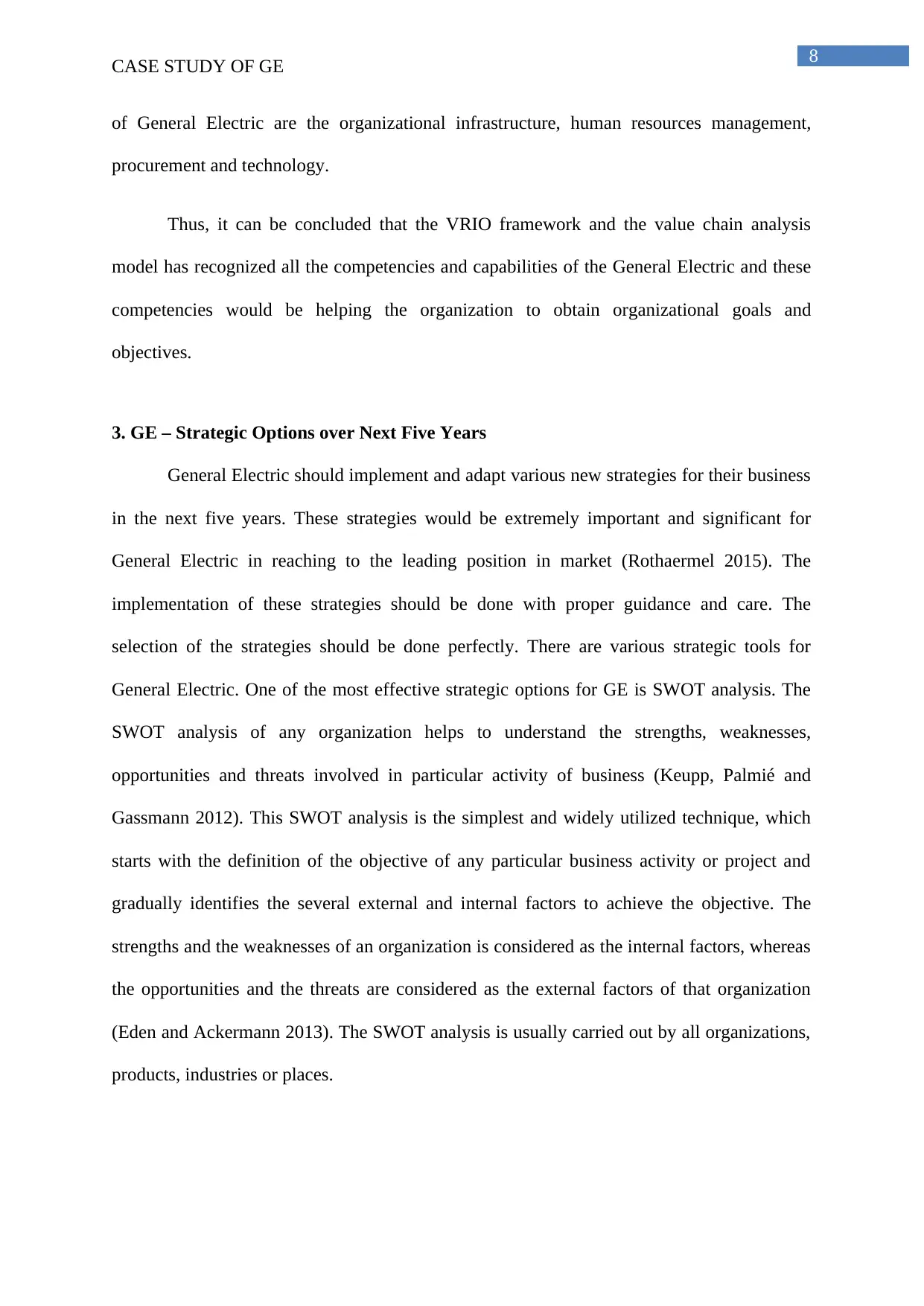
8
CASE STUDY OF GE
of General Electric are the organizational infrastructure, human resources management,
procurement and technology.
Thus, it can be concluded that the VRIO framework and the value chain analysis
model has recognized all the competencies and capabilities of the General Electric and these
competencies would be helping the organization to obtain organizational goals and
objectives.
3. GE – Strategic Options over Next Five Years
General Electric should implement and adapt various new strategies for their business
in the next five years. These strategies would be extremely important and significant for
General Electric in reaching to the leading position in market (Rothaermel 2015). The
implementation of these strategies should be done with proper guidance and care. The
selection of the strategies should be done perfectly. There are various strategic tools for
General Electric. One of the most effective strategic options for GE is SWOT analysis. The
SWOT analysis of any organization helps to understand the strengths, weaknesses,
opportunities and threats involved in particular activity of business (Keupp, Palmié and
Gassmann 2012). This SWOT analysis is the simplest and widely utilized technique, which
starts with the definition of the objective of any particular business activity or project and
gradually identifies the several external and internal factors to achieve the objective. The
strengths and the weaknesses of an organization is considered as the internal factors, whereas
the opportunities and the threats are considered as the external factors of that organization
(Eden and Ackermann 2013). The SWOT analysis is usually carried out by all organizations,
products, industries or places.
CASE STUDY OF GE
of General Electric are the organizational infrastructure, human resources management,
procurement and technology.
Thus, it can be concluded that the VRIO framework and the value chain analysis
model has recognized all the competencies and capabilities of the General Electric and these
competencies would be helping the organization to obtain organizational goals and
objectives.
3. GE – Strategic Options over Next Five Years
General Electric should implement and adapt various new strategies for their business
in the next five years. These strategies would be extremely important and significant for
General Electric in reaching to the leading position in market (Rothaermel 2015). The
implementation of these strategies should be done with proper guidance and care. The
selection of the strategies should be done perfectly. There are various strategic tools for
General Electric. One of the most effective strategic options for GE is SWOT analysis. The
SWOT analysis of any organization helps to understand the strengths, weaknesses,
opportunities and threats involved in particular activity of business (Keupp, Palmié and
Gassmann 2012). This SWOT analysis is the simplest and widely utilized technique, which
starts with the definition of the objective of any particular business activity or project and
gradually identifies the several external and internal factors to achieve the objective. The
strengths and the weaknesses of an organization is considered as the internal factors, whereas
the opportunities and the threats are considered as the external factors of that organization
(Eden and Ackermann 2013). The SWOT analysis is usually carried out by all organizations,
products, industries or places.
⊘ This is a preview!⊘
Do you want full access?
Subscribe today to unlock all pages.

Trusted by 1+ million students worldwide

9
CASE STUDY OF GE
i) Strengths: The features or the business characteristics, which provides competitive
advantages to the business over all others, are called strengths (Goetsch and Davis 2014). The
strong characteristics are known as strengths of that particular organization.
ii) Weaknesses: The features or the business characteristics, which provides
competitive disadvantages to the business over all others, are called weaknesses of that
business (Weiss 2014). The weak characteristics are known as the weaknesses of an
organization.
iii) Opportunities: The elements in an environment, which an organization can easily
utilize for gaining competitive advantages, are known as the opportunities of the
organization.
iv) Threats: The elements in an environment, which can easily create big problems in
an organization, are known as the threats of that particular organization.
The organization of General Electric has its own strengths, weaknesses, opportunities
and threats (Egan 2013). The SWOT analysis of General Electric is as follows:
CASE STUDY OF GE
i) Strengths: The features or the business characteristics, which provides competitive
advantages to the business over all others, are called strengths (Goetsch and Davis 2014). The
strong characteristics are known as strengths of that particular organization.
ii) Weaknesses: The features or the business characteristics, which provides
competitive disadvantages to the business over all others, are called weaknesses of that
business (Weiss 2014). The weak characteristics are known as the weaknesses of an
organization.
iii) Opportunities: The elements in an environment, which an organization can easily
utilize for gaining competitive advantages, are known as the opportunities of the
organization.
iv) Threats: The elements in an environment, which can easily create big problems in
an organization, are known as the threats of that particular organization.
The organization of General Electric has its own strengths, weaknesses, opportunities
and threats (Egan 2013). The SWOT analysis of General Electric is as follows:
Paraphrase This Document
Need a fresh take? Get an instant paraphrase of this document with our AI Paraphraser
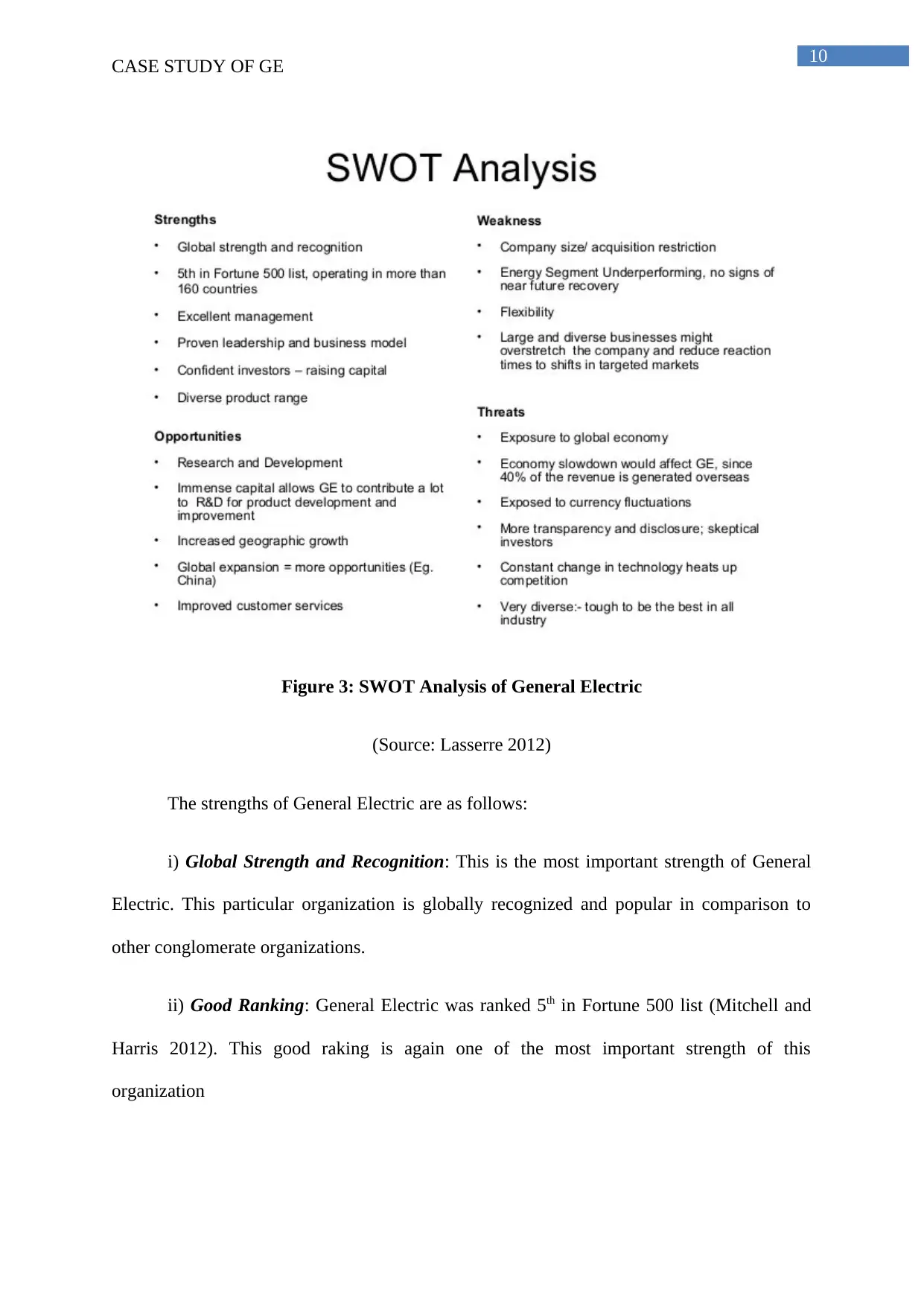
10
CASE STUDY OF GE
Figure 3: SWOT Analysis of General Electric
(Source: Lasserre 2012)
The strengths of General Electric are as follows:
i) Global Strength and Recognition: This is the most important strength of General
Electric. This particular organization is globally recognized and popular in comparison to
other conglomerate organizations.
ii) Good Ranking: General Electric was ranked 5th in Fortune 500 list (Mitchell and
Harris 2012). This good raking is again one of the most important strength of this
organization
CASE STUDY OF GE
Figure 3: SWOT Analysis of General Electric
(Source: Lasserre 2012)
The strengths of General Electric are as follows:
i) Global Strength and Recognition: This is the most important strength of General
Electric. This particular organization is globally recognized and popular in comparison to
other conglomerate organizations.
ii) Good Ranking: General Electric was ranked 5th in Fortune 500 list (Mitchell and
Harris 2012). This good raking is again one of the most important strength of this
organization
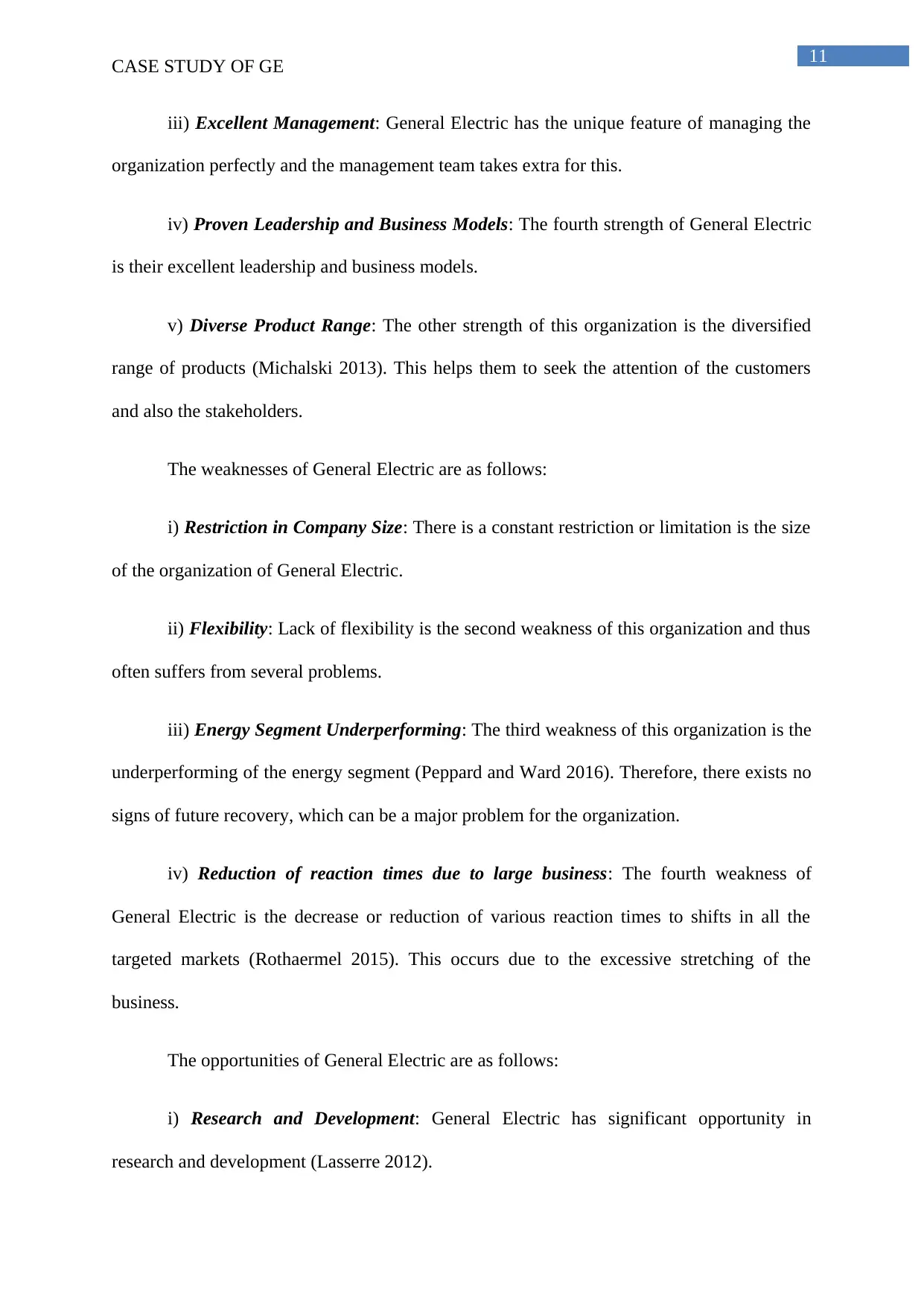
11
CASE STUDY OF GE
iii) Excellent Management: General Electric has the unique feature of managing the
organization perfectly and the management team takes extra for this.
iv) Proven Leadership and Business Models: The fourth strength of General Electric
is their excellent leadership and business models.
v) Diverse Product Range: The other strength of this organization is the diversified
range of products (Michalski 2013). This helps them to seek the attention of the customers
and also the stakeholders.
The weaknesses of General Electric are as follows:
i) Restriction in Company Size: There is a constant restriction or limitation is the size
of the organization of General Electric.
ii) Flexibility: Lack of flexibility is the second weakness of this organization and thus
often suffers from several problems.
iii) Energy Segment Underperforming: The third weakness of this organization is the
underperforming of the energy segment (Peppard and Ward 2016). Therefore, there exists no
signs of future recovery, which can be a major problem for the organization.
iv) Reduction of reaction times due to large business: The fourth weakness of
General Electric is the decrease or reduction of various reaction times to shifts in all the
targeted markets (Rothaermel 2015). This occurs due to the excessive stretching of the
business.
The opportunities of General Electric are as follows:
i) Research and Development: General Electric has significant opportunity in
research and development (Lasserre 2012).
CASE STUDY OF GE
iii) Excellent Management: General Electric has the unique feature of managing the
organization perfectly and the management team takes extra for this.
iv) Proven Leadership and Business Models: The fourth strength of General Electric
is their excellent leadership and business models.
v) Diverse Product Range: The other strength of this organization is the diversified
range of products (Michalski 2013). This helps them to seek the attention of the customers
and also the stakeholders.
The weaknesses of General Electric are as follows:
i) Restriction in Company Size: There is a constant restriction or limitation is the size
of the organization of General Electric.
ii) Flexibility: Lack of flexibility is the second weakness of this organization and thus
often suffers from several problems.
iii) Energy Segment Underperforming: The third weakness of this organization is the
underperforming of the energy segment (Peppard and Ward 2016). Therefore, there exists no
signs of future recovery, which can be a major problem for the organization.
iv) Reduction of reaction times due to large business: The fourth weakness of
General Electric is the decrease or reduction of various reaction times to shifts in all the
targeted markets (Rothaermel 2015). This occurs due to the excessive stretching of the
business.
The opportunities of General Electric are as follows:
i) Research and Development: General Electric has significant opportunity in
research and development (Lasserre 2012).
⊘ This is a preview!⊘
Do you want full access?
Subscribe today to unlock all pages.

Trusted by 1+ million students worldwide
1 out of 22
Related Documents
Your All-in-One AI-Powered Toolkit for Academic Success.
+13062052269
info@desklib.com
Available 24*7 on WhatsApp / Email
![[object Object]](/_next/static/media/star-bottom.7253800d.svg)
Unlock your academic potential
Copyright © 2020–2025 A2Z Services. All Rights Reserved. Developed and managed by ZUCOL.





